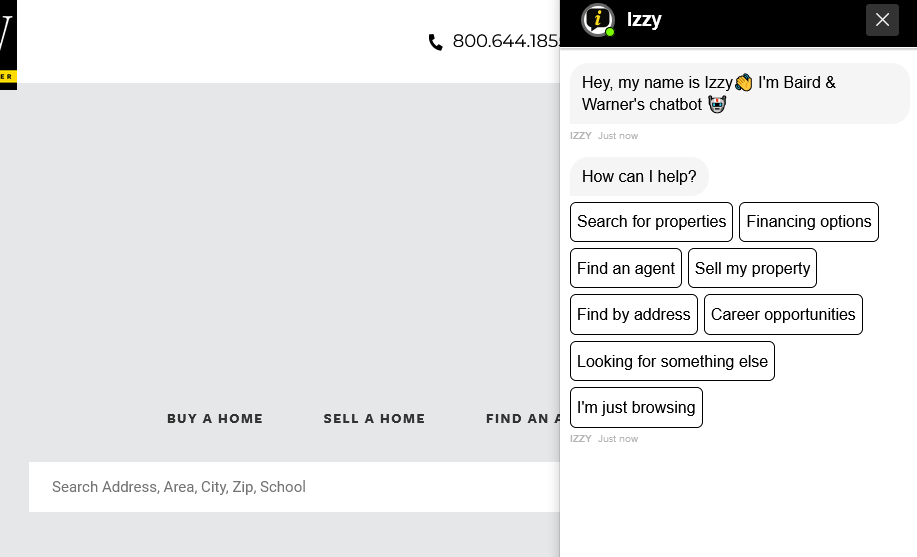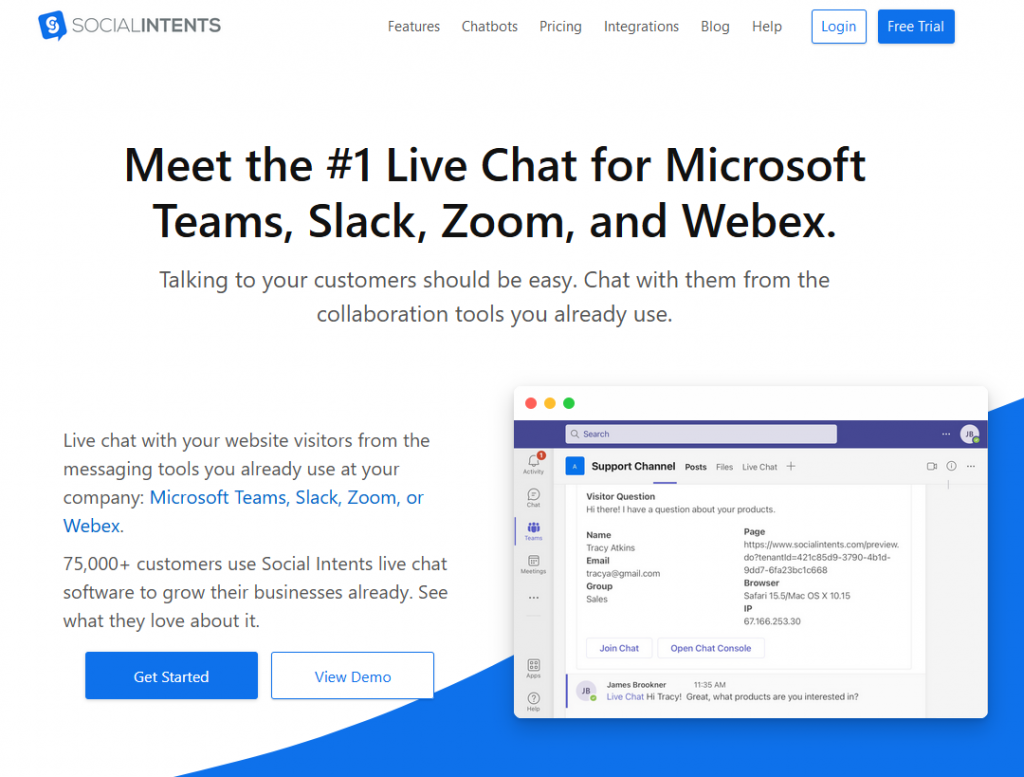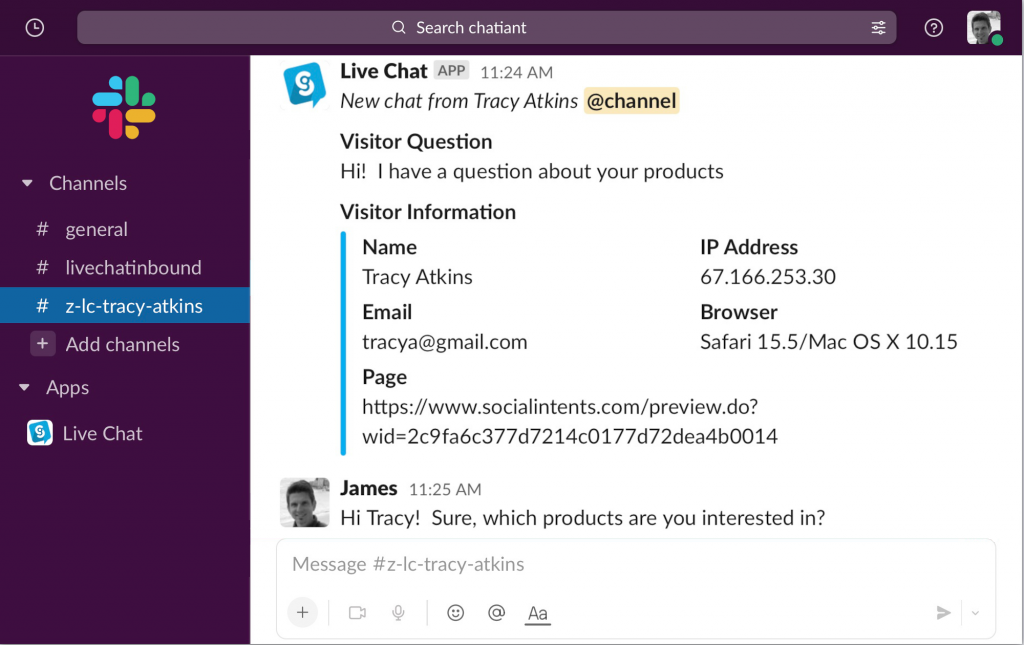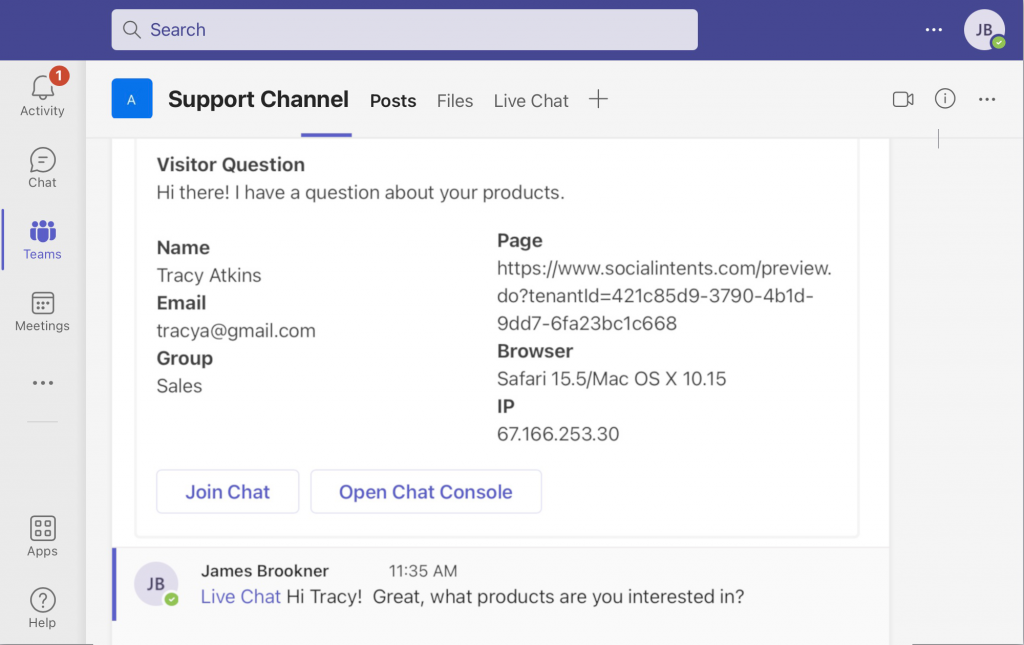¿Has visto a otras agencias inmobiliarias utilizar el chat en directo y te preguntas cómo podrías hacer tú lo mismo? ¿Busca consejos sobre cómo utilizar el chat en directo para las agencias inmobiliarias?
Pues estás de suerte.
A continuación encontrará una guía completa sobre el uso del chat en directo en el sector inmobiliario.
Y empecemos con esto...
¿Por qué es tan importante el chat en directo para el sector inmobiliario hoy en día?
Como agente inmobiliario, ya lo sabe: El sector inmobiliario es enorme.
En septiembre del año pasado, la tasa de propietarios de vivienda en Estados Unidos ascendió al 66%. El 79,5% de las personas de 65 años o más eran propietarias de su vivienda. De los que tenían entre 35 y 44 años, el 62,5% era propietario de su vivienda, y así sucesivamente.
En otras palabras, preferimos comprar viviendas, y eso es una gran noticia para usted.
Pero hay más...
Casi la mitad de los compradores buscan en Internet antes de ponerse en contacto con un agente inmobiliario. Solo el 18% de los compradores inició la búsqueda de vivienda poniéndose en contacto con un agente inmobiliario.
Y éste es, probablemente, el dato más importante: el 86% de los compradores considera que los agentes inmobiliarios son una fuente de información muy útil.
Esto sugiere que los compradores sí utilizan Internet para buscar propiedades. Pero siguen queriendo charlar con un agente inmobiliario antes de tomar una decisión.
¿Qué tiene esto que ver con el chat en directo? Bueno, el chat en directo combina ambos aspectos. Forma parte de una experiencia de búsqueda online y conecta a los compradores con los agentes MIENTRAS atraviesan esa experiencia.
El chat en directo le permite a usted y a sus colegas mantener conversaciones en tiempo real con compradores potenciales que estén viendo su sitio web en ese momento.
La conversación tiene lugar a través de un pequeño widget de chat en directo que usted coloca en su sitio web. Los clientes pueden publicar sus preguntas allí y conectar directamente con un agente inmobiliario.
Por ejemplo:

Pero a diferencia de lo que ocurre con los teléfonos, con el chat en directo los compradores pueden conversar con usted estén donde estén, y nadie a su alrededor sabría siquiera que lo están haciendo.
Se trata de un factor importante, ya que muchos compradores miran propiedades mientras trabajan y preferirían no ser descubiertos por hacerlo.
Pero esta comodidad es sólo una de las muchas ventajas de utilizar el chat en directo en el sector inmobiliario.
Veámoslos todos en detalle.
Ventajas de utilizar el chat en directo en el sector inmobiliario
Mayor compromiso del cliente. Uno de los principales retos a los que se enfrentan los agentes inmobiliarios es que, aunque los clientes buscan propiedades en línea, a menudo abandonan el sitio web sin realizar ninguna acción.
Para algunos, es demasiado pronto para concertar una cita. Aún no han llegado a esa fase del proceso de compra. Otros, en cambio, prefieren obtener más información antes de decidirse a concertar una cita.
El chat en directo ayuda a resolver esas situaciones. Ofrece a los clientes una forma sencilla de conectar con sus agentes y preguntarles cualquier duda que tengan sin comprometerse a nada importante.
Comodidad. Con el chat en directo, sus agentes inmobiliarios pueden hablar sobre las necesidades de un cliente, averiguar qué está buscando y recomendarle viviendas u otras propiedades. Pueden comentar todos los pormenores de cada sugerencia y reservar esas visitas.
Y lo que es importante, todo esto puede ocurrir independientemente de dónde se encuentre el cliente en ese momento.
Más clientes potenciales. Los formularios y encuestas previos al chat le permiten establecer un embudo de generación de clientes potenciales con el chat en directo y convertir a los visitantes en nuevos compradores potenciales. A continuación, puede utilizar otros canales, como el correo electrónico, para captarlos y tenerlos en cuenta mientras buscan una nueva propiedad.
Te mostraré cómo hacerlo todo en la práctica
He aquí exactamente cómo utilizar el chat en directo para un negocio inmobiliario
La principal ventaja de utilizar el chat en directo es que le permite ofrecer a los clientes un canal nuevo y en tiempo real para conectar con su empresa.
Pero, naturalmente, hay algo más que el widget que los compradores potenciales pueden utilizar para chatear con usted.
Así pues, hablemos de cómo el chat en directo le ayuda a captar compradores potenciales y a ponerlos en contacto con su negocio inmobiliario.
#1. Con el chat en directo, los clientes pueden hacer preguntas y obtener asesoramiento en tiempo real.
Este es, con diferencia, el caso de uso más obvio para el chat en directo en cualquier sector.
El chat en directo ofrece a los clientes acceso directo a sus agentes.
Esto significa que los clientes ya no tienen que llamar o visitar su agencia para hacer preguntas, averiguar si tiene propiedades que se ajusten a sus expectativas y obtener asesoramiento.
#2. El chat en directo ayuda a los agentes inmobiliarios a establecer una mejor relación con compradores y vendedores
En realidad, esto ocurre de varias maneras.
Por un lado, con el chat en directo, sus agentes inmobiliarios pueden conectar con los compradores potenciales en las primeras fases del proceso de compra. Esto puede ocurrir incluso durante la primera visita a su sitio web.
Por ejemplo, sus agentes inmobiliarios pueden mostrar de forma proactiva mensajes de bienvenida y activadores para incitar a los visitantes a iniciar conversaciones de chat en directo.

#3. Sus agentes pueden utilizar el chat en directo para sugerir propiedades y reservar visitas.
El objetivo de utilizar el chat en directo para una agencia inmobiliaria es conectar más rápidamente con los compradores potenciales. Lo que normalmente requeriría que al menos llamaran y, en el mejor de los casos, visitaran sus oficinas, ahora puede ocurrir instantáneamente en línea.
Esto también significa que sus agentes pueden utilizar el chat en directo para hablar de las necesidades de los clientes. Pueden sugerir propiedades e incluso explicar las ventajas de cada opción mientras el comprador ve la información y las fotos de la propiedad en línea. Al final de la conversación, pueden programar visitas para aquellas propiedades que hayan captado el interés de la persona.
#4. Los chatbots pueden ayudarle a procesar consultas fuera del horario de oficina
Los chatbots, como su nombre podría sugerir, son robots automatizados que pueden procesar algunas interacciones básicas de chat en vivo y atraer a los clientes cuando sus agentes están ocupados.
Naturalmente, esto no significa que esos bots hagan todo lo que podría hacer una persona real. Ni mucho menos. Pero puedes configurarlos para que procesen algunas interacciones básicas:
- Los chatbots pueden recibir un mensaje y reenviarlo a un agente cuando vuelva a estar en línea.
- Un chatbot puede presentar a una persona una lista de páginas que podría ver mientras sus agentes están fuera.
- Chatbot puede responder a las preguntas básicas de los clientes sobre el funcionamiento de su agencia inmobiliaria.
- Los chatbots también podrían dirigir a los clientes a propiedades relevantes que usted haya listado, etc.
LECTURA ADICIONAL: Más información sobre la diferencia entre chat en directo y chatbots.
Por ejemplo, este chatbot ayuda a dirigir la consulta de una persona al agente pertinente. Gracias a esto, en lugar de ser redirigido de un agente a otro, el cliente puede chatear inmediatamente con la persona más relevante.

Y este chatbot puede responder a algunas preguntas básicas de los clientes.

LEER MÁS: Descubra cómo los chatbots ayudan a aumentar las ventas.
Lo único que impide a los agentes inmobiliarios utilizar el chat en directo
Ya te he hablado mucho del chat en directo. Ya sabes por qué tu agencia inmobiliaria debería usarlo y cómo.
Pero también tengo que hablarte de la objeción número 1 que escucho de los agentes inmobiliarios con respecto al despliegue del chat en directo en sus sitios.
Y, sorprendentemente, no tiene nada que ver con no tener tiempo para charlar con los clientes.
Pero tomémoslo desde el principio.
Implementar el chat en directo suele significar tres cosas:
En primer lugar, tienes que conseguir un nuevo programa informático. También tienes que aprender a utilizarlo, obviamente.
A continuación, tienes que añadir un widget de chat en directo a tu sitio. (Por suerte, esa parte es ridículamente fácil).
Y, por último, tienes que aprender a alternar entre tu herramienta de comunicación habitual y el chat en directo.
Ahora bien, puedo decirte que, junto con tener que aprender una nueva herramienta, este último punto es, con diferencia, uno de los aspectos más frustrantes del chat en directo. Esto se debe a que, normalmente, para utilizar el chat en directo, tienes que cambiar constantemente de la herramienta que utilizas normalmente para comunicarte (es decir, MS Teams o Slack) a la interfaz del chat en directo.
Esto no sólo requiere procesos de gestión de las distintas herramientas. También significa que tiene que facilitar la colaboración entre dos plataformas. Después de todo, sus agentes podrían necesitar ayuda de otro departamento. En este caso, tendrían que volver a Teams o Slack, pedir consejo a un compañero relevante y copiar y pegar su respuesta en el chat en directo.
Esto no sólo consume mucho tiempo, sino que también puede dar lugar a graves errores humanos, omisiones y frustración para los clientes.
Por suerte, hay otra manera...
Cómo utilizar el chat en directo SIN tener que cambiar de plataforma
Un software de chat en directo típico funciona de forma independiente de cualquier otra herramienta de comunicación que pueda estar utilizando: Microsoft Teams, Slack, Zoom, etc.
Utiliza una interfaz distinta, un conjunto diferente de funciones y atajos de palabras clave, y básicamente requiere que los agentes inicien sesión en la plataforma para procesar las conversaciones de chat en directo.
Pero no es el caso de Social Intents.

Social Intents (descargo de responsabilidad: es mi herramienta) es una solución de chat en directo que facilita la conversación con compradores potenciales desde las herramientas que ya utilizas: Slack, MS Teams, Zoom o Webex.
Con Social Intents, puede chatear con cualquier persona que visite su sitio web inmobiliario sin salir de su herramienta de mensajería. Social Intents se conecta con su herramienta y dirige allí todas las conversaciones de chat.
Su personal puede recoger conversaciones de clientes directamente en Slack o Teams, de esta manera:

(Chat en directo en Slack con Social Intents)

(Chat en directo en MS Teams con Social Intents)
Pero aquí viene lo mejor: usted procesa las consultas en su herramienta de mensajería favorita. Los clientes, por su parte, experimentan la conversación como si estuvieran utilizando una interfaz de chat en directo tradicional.
Porque, en definitiva, eso es Social Intents, una solución de chat en directo para concesionarios de automóviles pero sin la molestia de tener que cambiar de herramienta para procesar las consultas de los clientes.
Estas son algunas de las increíbles funciones que puede esperar de nuestro chat en directo sobre automoción:
- Widget de chat personalizable
- Respuestas enlatadas para acelerar la resolución de consultas
- Invitaciones proactivas al chat para iniciar conversaciones con los visitantes
- Reglas de segmentación que le permiten mostrar el chat sólo a los clientes más relevantes
- Número ilimitado de miembros del equipo
- Increíbles integraciones con terceros, como CRM, atención al cliente o sistemas de tickets, entre otros.
